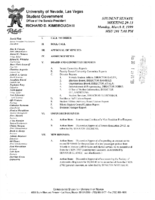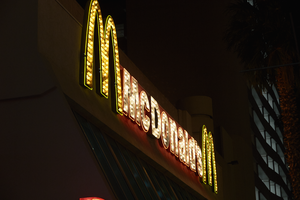Search the Special Collections and Archives Portal
Search Results

Meeting minutes for Consolidated Student Senate University of Nevada, Las Vegas, March 8, 1999
Date
Archival Collection
Description
Text

Transcript of interview with Donald E. Klinker by Barbara Fidelman, February 13, 1975
Date
Archival Collection
Description
On February 13, 1975, Barbara Fidelman interviewed former Caesar’s Palace cage manager, Donald E. Klinkner (born November 28th, 1935 in Los Angeles, California) in his home about his life and perspectives on Southern Nevada. The two discuss the different recreational activities that Klinker participated in during the fifties and sixties. The interview concludes with Klinkner explaining the misconceptions that tourists have about Las Vegas, Nevada.
Text

Photographs of The D signs, Las Vegas (Nev.), April 18, 2017
Date
Archival Collection
Description
Site address: 301 Fremont St
Sign owner: Derek Stevens
Sign details: This location first opened as the Sundance in 1980 which was known for its affiliation with Moe Dalitz of the Cleveland syndicate. Then the location was reopened in 1987 as the Fitzgerald's by owner Don Barden, one of the first African American casino owners in Las Vegas. Then in 2012 the renovation process began for Derek Stevens to open up the D casino. The D is named after Derek Steven's hometown of Detroit, Michigan.
Sign condition: 5- Very good condition
Sign form: Variation of a Bull Nose sign, signs on buildings and other entrance signs
Sign-specific description: Above their main entrance on Third and Fremont there is a black backdrop that states "the D" the letters the are in gold lights, then the letter D is in a big red steel box that showcases a tv screen in the big part of the letter, but this letter is outlined in two strips of red neon. Underneath this variation of a bull nose sign is a tv plasma screen that they have wrapped around the building. - On the second story of their casino there is a Vintage Vegas section that can be accessed from the street via escalator, above this second floor entrance is a sign stating "the D Vintage Vegas" At the Top of the building is an animated sculptural sign which is a slot machine with a lever that pulls down with the reels changing such as an old slot machine would have done. Then below this are neon coins that light up in order to look like they are falling out of the slot machine. On the top left portion of the coins states "the (in white) D (in red)", but under the logo is a solid yellow neon line. On top of the yellow line states "Vintage" and on the bottom states "Vegas" in a retro 50's 60's font.
Sign - type of display: Neon, LED, Plasma screen
Sign - media: Steel, some plastic
Sign - non-neon treatments: Light bulbs, T.V. screen and sculptural sign
Sign animation: The coins light up in order to look as though they are falling out of the sculptural slot machine. The lever on the slot machine moves to activate the moving reels in the slot machine.
Sign environment: On the corner of Third and Fremont St. West of the building is the Four Queens, to the North West is the Fremont Casino and Hotel. Across Fremont street from the D is little shops including where the El Portal Movie Theater used to be. Also along Fremont Street the D opened a bar which is very helpful with foot traffic. Also Third Street right in front of their main entrance there is a stage that hold concerts.
Sign manufacturer: AD/S Companies
Sign - date of installation: 2012
Sign - thematic influences: This variation of a Bull Nose sign is similar to many of the other entrance signs for casinos on Fremont Street.
Sign - artistic significance: The Vintage Vegas sign has a retro 1950's/60's type font. The sign really does represent the theme of that section of the casino well by having the old slot machine sculptural sign.
Survey - research locations: Acessor's office website, the D website http://www.thed.com/hotel/ , Neon Museum Tour Manual
Survey - research notes: Derek Stevens also owns the Golden Gate. He bought out the Glitter Gulch, Mermaids and La Bayou in 2015 then the Las Vegas club in 2016. La Bayou was demolished in 2016. The summer of 2017 is when the demolition of Glitter Gulch, Mermaids and the Las Vegas Club began.
Surveyor: Emily Fellmer
Survey - date completed: 2017-08-12
Sign keywords: Neon; LED; Steel; Plastic; Bullnose; Building-front design; Plasma display; Video screen; Sculptural
Mixed Content
Sook-ja Kim oral history interviews
Identifier
Abstract
Oral history interviews with Sook-ja Kim conducted by Myoung-ja Lee Kwon on February 12, 1996 and April 06, 1996 for the Women's Research Institute of Nevada (WRIN) Las Vegas Women Oral History Project. Kim begins her interview discussing her family's background in singing in Korea and she then transitions to her and her sisters' arrival to Las Vegas, Nevada in 1959. Kim discusses their Las Vegas act, singing rock 'n' roll tunes at the Thunderbird Hotel. Kim goes on to discuss her groups' big break, performing on the Ed Sullivan Show. Kim describes how this event ignited a successful touring period for the sisters and the eventual launching of another group, the Kim Brothers, comprised of Sook-ja Kim's brothers. Kim ends the interview discussing what challenges Koreans face when moving to America and important information she thinks future Korean immigrants should know or consider.
Archival Collection
Dorothy Eisenberg oral history interviews
Identifier
Abstract
Oral history interviews with Dorothy Eisenberg conducted by Caryll Batt Dziediak on February 16, 2001, November 14, 2006, November 21, 2006, March 02, 2007, and July 11, 2007 for the Women's Research Institute of Nevada (WRIN) Las Vegas Women Oral History Project. Eisenberg begins her interviews with a history of her family and discussion of her Jewish heritage and its influence on her life. Eisenberg continues her interview by covering her life events in chronological order, including her education, the birth of her children, and her husband's plane crash and death. Eisenberg then discusses rebuilding her life and her political activism in the Philadelphia, Pennsylvania Jewish community. Eisenberg lastly discusses her move to Las Vegas, Nevada and her involvement in many community organizations and issue, such as the League of Women Voters, Women's Democratic Club, welfare rights, school integration, and the Equal Rights Amendment.
Archival Collection
Frances Montes oral history interviews
Identifier
Abstract
Oral history interviews with Frances Montes conducted by Barbara Agonia on October 25, 2001, November 02, 2001, December 28, 2001, and August 24, 2002 for the Women's Research Institute of Nevada (WRIN) Las Vegas Women Oral History Project. Montes begins her interviews by describing growing up in a Latinx community in San Antonio, Texas in the 1940s. She discusses the rich culture of her community as well as her experiences with racism. Montes then describes her adult life with her husband Jerry and living overseas in France and Spain and her experiences working for the the civil service while abroad. Montes later talks about returning to the United States and her family's move to Las Vegas, Nevada in 1970. Montes discusses joining the Nevada Association of Latin Americans (NALA) and goes on to describe her involvement in the Las Vegas community, working to recruit Latinx students to the community college system, working for NALA, the Latin Chamber of Commerce, and eventually becoming president of Hispanics in Politics (HIP).
Archival Collection
Margaret and Frank Price oral history interview
Identifier
Abstract
Oral history interview with Margaret and Frank Price conducted by Joanne L. Goodwin on March 05, 1997 for the Women's Research Institute of Nevada (WRIN) Las Vegas Women Oral History Project. Margaret Price opens the interview by describing the family's move from Ohio to Las Vegas, Nevada for Frank's health in 1950. Price then moves on to describe her experiences and the people she met while working as a waitress at the El Rancho Hotel and Casino. Margaret and Frank Price then discuss Margaret's career at the Dunes, and the variety of entertainment acts available in the 1950s. The Prices also describe job stability, worker benefits, and unions during the 1950s. Frank then discusses organized crime in Las Vegas and its relation to law enforcement and sex work. He also talks about the various casinos he worked at and the effects that the shift from individual owners to corporate ownership had on the casino industry. The interview ends with both Prices sharing their memories and knowledge of Binion's Hotel and Casino.
Archival Collection
Stella Champo Iaconis oral history interviews
Identifier
Abstract
Oral history interview with Stella Champo Iaconis conducted by Kay Long on May 14, 1997, May 21, 1997, May 26, 1997, and September 22, 1997 for the Women's Research Institute of Nevada (WRIN) Las Vegas Women Oral History Project. Iaconis opens her interviews discussing her difficult upbringing and life on a ranch in Las Vegas, Nevada with her dad in the 1910s and 1920s. Iaconis then describes her experiences as a waitress in Las Vegas. As the interviews continue, Iaconis discusses Block 16 and sex work, the Helldorado Days, and life in 1930s Las Vegas. Iaconis ends the interview talking about her father and his career as a miner; her many husbands; and her personal history in Las Vegas.
Archival Collection
Nancy Houssels oral history interviews
Identifier
Abstract
Oral history interviews with Nancy Houssels conducted by Caryll Batt Dziedziak on November 18, 1998, December 07, 1998, and December 14, 1998 for the Women's Research Institute of Nevada (WRIN) Las Vegas Women Oral History Project. Houssels begins her interviews discussing her childhood in California and the influence World War II had on her upbringing. Houssels then talks about her dance training and career including topics on her auditions, her dance partners, and touring Europe in the 1960s. Houssels describes coming to Las Vegas, Nevada in 1968 where she was booked as a dancer in Folies Bergere at the Tropicana Hotel. Houssels then discusses the influences Mormonism and adiago ballet had on her life. Houssels then describes how she co-founded the Nevada Ballet Theatre with Vassili Sulich, performances of the company, their dancers, and community outreach.
Archival Collection
Joseph J. Buckley oral history interview
Identifier
Abstract
Oral history interview with Joseph J. Buckley conducted by Patrick Carlton on July 17, 2002 for the Boyer Early Las Vegas Oral History Project. Buckley opens his interview by detailing his participation in the Rotary Club of Las Vegas, Nevada, including offices he held. He then recalls his upbringing in New York through the mid-1950s, his employment at Rockwell International, and the work he did to test components of the Apollo 11 spacecraft. He then discusses moving to Las Vegas in 1969 to become the Personnel Director at the Desert Inn Hotel and Casino and recalls opening his own human resources consulting firm in 1985. He then describes the Rotary Club in more detail including the club philosophy, fundraising auctions, the scholarships they offered, and their short-lived television program. Buckley further talks about the Rotary Club's campaign to eradicate polio globally, events that occurred during his club presidency in the 1980s, and his time as Rotary Club District Governor in 1985. He then discusses overseeing a global Rotary Club convention in Las Vegas during the 1980s, and dealing with a lawsuit filed against the Rotary Club organization for discrimination against women. He recalls his time in Human Resources for the Howard Hughes Corporation, and a lawsuit filed against the Las Vegas hotel industry for employment discrimination against African Americans. Lastly, Buckley talks about the expansion of Las Vegas, the increase the city's population, and labor union relations.
Archival Collection
